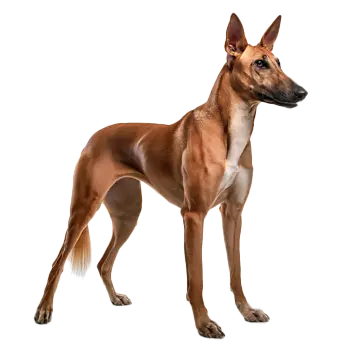American Kennel Club (AKC)
The South Saharan Greyhound is currently registered with the AKC Foundation Stock Service but has not yet achieved full recognition status. The FSS maintains records for this breed as it works toward meeting population and organizational requirements for eventual full AKC recognition. Enthusiasts in North America continue working to establish breeding programs that adhere to international standards while building the necessary documentation and club infrastructure. The breed's progression through FSS represents an important step toward broader recognition in the United States, where sighthound appreciation continues to grow among discerning dog fanciers.
Fédération Cynologique Internationale (FCI)
The FCI recognizes the Sloughi under Standard Number 188, classified in Group 10 (Sighthounds), Section 3 (Short-haired Sighthounds). The standard describes a medium-sized sighthound with a distinguished, racy appearance. General appearance emphasizes a dog with a short coat, bony and muscular structure, giving the impression of fineness and robustness simultaneously. The head is elongated with a slightly rounded skull, tapering muzzle, and dark, large eyes with a gentle, somewhat sad expression. Ears are triangular with slightly rounded tips, hanging flat against the head. The body shows a pronounced tuck-up with visible hip bones. Height for males ranges from 66-72 cm at withers, females 61-68 cm. Colors include all shades of light sand to mahogany red-sand, with or without black mask, black mantle, black overlay, or brindling. White markings are tolerated only as a narrow blaze on the chest. The gait is supple and light with great elasticity. Temperament is described as noble and proud, attached to its master, with a strong hunting instinct.
United Kennel Club (UKC)
The UKC recognizes the Sloughi in the Sighthound and Pariah Dog Group. The UKC standard emphasizes the breed's historical role as a hunting companion to nomadic desert peoples, noting its ability to hunt by sight and scent over difficult terrain. The standard describes a medium-sized hound with a short, smooth coat, strong bone structure, and well-developed muscles visible beneath the skin. The head is long and refined with a gentle expression. Body proportions emphasize length and depth necessary for endurance and speed. The standard notes that males should appear masculine without coarseness while females should appear feminine without excessive refinement. Movement should be effortless and ground-covering. Temperament is described as reserved and dignified, loyal to family but cautious with strangers. The UKC standard particularly emphasizes the importance of functional conformation over cosmetic considerations, maintaining that the breed should retain its capabilities as a coursing hound.
Other Organizations
Various national kennel clubs maintain breed standards aligned with FCI guidelines, including organizations in Morocco, Algeria, Tunisia, France, and other European countries where the breed has established populations. The Sloughi Club of America works to promote and preserve the breed in North America, maintaining studbook records and coordinating with international organizations. Breed enthusiasts emphasize the importance of preserving working characteristics alongside physical type, recognizing that these desert-adapted sighthounds possess unique qualities developed over millennia of selective breeding in harsh environments.

